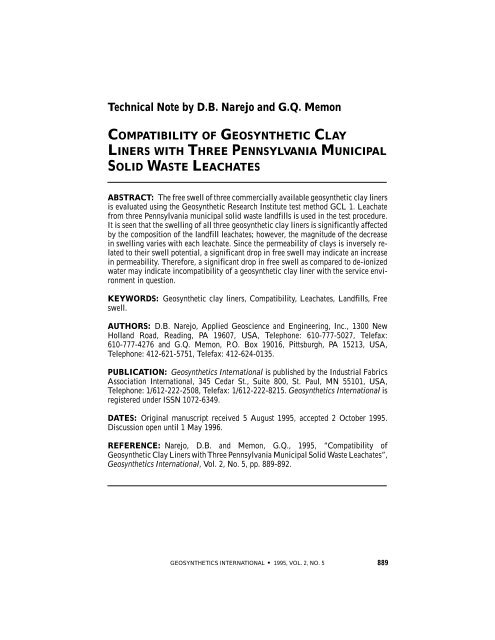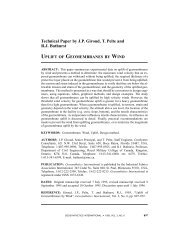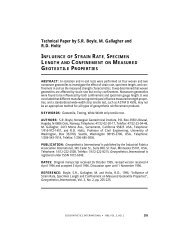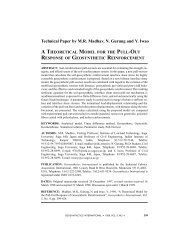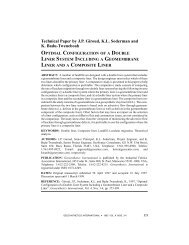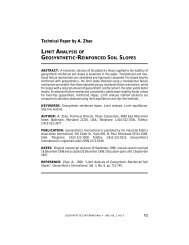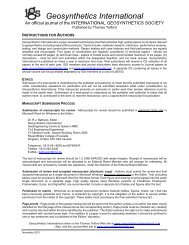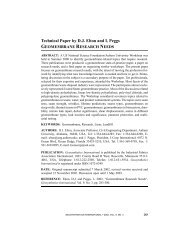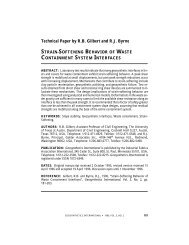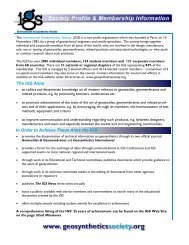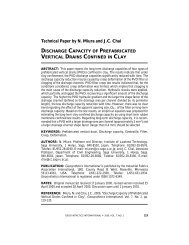Technical Note by D.B. Narejo and G.Q. Memon - IGS - International ...
Technical Note by D.B. Narejo and G.Q. Memon - IGS - International ...
Technical Note by D.B. Narejo and G.Q. Memon - IGS - International ...
Create successful ePaper yourself
Turn your PDF publications into a flip-book with our unique Google optimized e-Paper software.
<strong>Technical</strong> <strong>Note</strong> <strong>by</strong> D.B. <strong>Narejo</strong> <strong>and</strong> G.Q. <strong>Memon</strong><br />
COMPATIBILITY OF GEOSYNTHETIC CLAY<br />
LINERS WITH THREE PENNSYLVANIA MUNICIPAL<br />
SOLID WASTE LEACHATES<br />
ABSTRACT: The free swell of three commercially available geosynthetic clay liners<br />
is evaluated using the Geosynthetic Research Institute test method GCL 1. Leachate<br />
from three Pennsylvania municipal solid waste l<strong>and</strong>fills is used in the test procedure.<br />
It is seen that the swelling of all three geosynthetic clay liners is significantly affected<br />
<strong>by</strong> the composition of the l<strong>and</strong>fill leachates; however, the magnitude of the decrease<br />
in swelling varies with each leachate. Since the permeability of clays is inversely related<br />
to their swell potential, a significant drop in free swell may indicate an increase<br />
in permeability. Therefore, a significant drop in free swell as compared to de-ionized<br />
water may indicate incompatibility of a geosynthetic clay liner with the service environment<br />
in question.<br />
KEYWORDS: Geosynthetic clay liners, Compatibility, Leachates, L<strong>and</strong>fills, Free<br />
swell.<br />
AUTHORS: D.B. <strong>Narejo</strong>, Applied Geoscience <strong>and</strong> Engineering, Inc., 1300 New<br />
Holl<strong>and</strong> Road, Reading, PA 19607, USA, Telephone: 610-777-5027, Telefax:<br />
610-777-4276 <strong>and</strong> G.Q. <strong>Memon</strong>, P.O. Box 19016, Pittsburgh, PA 15213, USA,<br />
Telephone: 412-621-5751, Telefax: 412-624-0135.<br />
PUBLICATION: Geosynthetics <strong>International</strong> is published <strong>by</strong> the Industrial Fabrics<br />
Association <strong>International</strong>, 345 Cedar St., Suite 800, St. Paul, MN 55101, USA,<br />
Telephone: 1/612-222-2508, Telefax: 1/612-222-8215. Geosynthetics <strong>International</strong> is<br />
registered under ISSN 1072-6349.<br />
DATES: Original manuscript received 5 August 1995, accepted 2 October 1995.<br />
Discussion open until 1 May 1996.<br />
REFERENCE: <strong>Narejo</strong>, D.B. <strong>and</strong> <strong>Memon</strong>, G.Q., 1995, “Compatibility of<br />
Geosynthetic Clay Liners with Three Pennsylvania Municipal Solid Waste Leachates”,<br />
Geosynthetics <strong>International</strong>, Vol. 2, No. 5, pp. 889-892.<br />
GEOSYNTHETICS INTERNATIONAL S 1995, VOL. 2, NO. 5<br />
889
NAREJO AND MEMON D Compatibility of GCLs with Municipal Solid Waste Leachates<br />
1 INTRODUCTION<br />
The compatibility of geosynthetic materials with the end use environment requires<br />
serious consideration. For polymeric materials, such as geomembranes <strong>and</strong> geotextiles,<br />
compatibility is usually evaluated according to Environmental Protection Agency<br />
(EPA) Method 9090, or a modified form of it. For compacted clay liners the EPA Method<br />
9100 is usually recommended for the same purpose. Since geosynthetic clay liners<br />
(GCLs) are composites of clay <strong>and</strong> polymeric materials, it may be necessary, in some<br />
critical applications, to evaluate the compatibility of the polymeric material according<br />
to EPA Method 9090 <strong>and</strong> the clay according to EPA Method 9100.<br />
The EPA Method 9100 is time consuming, thus, it may be desirable to estimate the<br />
compatibility of the clay component of GCLs with a leachate <strong>by</strong> evaluating its free<br />
swell. Free swell tests may be performed according to Geosynthetic Research Institute<br />
(GRI) test method GCL 1 or a similar test.<br />
In general, the higher the swell potential of a clay, the lower its permeability <strong>and</strong> vice<br />
versa; e.g. montmorillonite possesses a higher swell potential <strong>and</strong> lower permeability<br />
than kaolinite. Similarly, a liquid that causes a decrease in swell potential will also<br />
cause an increase in permeability; e.g. when using diesel <strong>and</strong> benzene as permeants, the<br />
free swell of GCLs will be lower <strong>and</strong> permeability higher than with de-ionized water.<br />
Should a GCL show incompatibility with a particular service environment, some of<br />
the following options may be considered:<br />
1. Use a different type of GCL.<br />
2. If possible, modify the clay component of the GCL to obtain compatibility with the<br />
service environment.<br />
3. Use a compacted clay liner; however, the question of compatibility still remains.<br />
2 GEOSYNTHETIC CLAY LINERS USED IN STUDY<br />
Three commercially available GCLs were used in this study. The GCLs are identified<br />
as Type 1, Type 2 <strong>and</strong> Type 3. The clay component, including any fibers <strong>and</strong> adhesive,<br />
was separated from each GCL sample type <strong>and</strong> used to perform the free swell tests.<br />
3 LEACHATES USED IN STUDY<br />
The leachate for these tests was obtained from three municipal solid waste l<strong>and</strong>fills<br />
in the state of Pennsylvania. The l<strong>and</strong>fills were selected such that the organic <strong>and</strong> ionic<br />
leachate concentrations ranged from mild to high. Consequently, the leachates in this<br />
paper are identified as mild, medium <strong>and</strong> harsh. The harsh leachate had the highest concentration<br />
of organics <strong>and</strong> ions, the mild leachate had the lowest, <strong>and</strong> the medium leachate<br />
had concentrations of organics <strong>and</strong> ions between the two.<br />
890 GEOSYNTHETICS INTERNATIONAL S 1995, VOL. 2, NO. 5
NAREJO AND MEMON D Compatibility of GCLs with Municipal Solid Waste Leachates<br />
4 TEST METHOD<br />
The GRI test method GCL 1 was used to perform all of the free swell tests. The test<br />
method requires 100 g of the clay component of the GCL together with any associated<br />
fibers <strong>and</strong> adhesive. The specimen is then hydrated with de-ionized water. The clay is<br />
spread evenly on the bottom of a 150 mm diameter California Bearing Ratio (CBR)<br />
mold which has a porous steel base plate. A porous steel loading plate with an extension<br />
rod is placed on top of the clay imposing a dead weight of approximately 0.68 kPa. The<br />
CBR mold is placed in a container <strong>and</strong> de-ionized water is added to the container <strong>and</strong><br />
the CBR mold. The total swell after 24 hours, <strong>and</strong> the time-swell curves are recorded.<br />
In this note only the total swell values are reported.<br />
5 TEST RESULTS<br />
The free swell values for the GCLs with de-ionized water <strong>and</strong> the different leachates<br />
are given in Table 1. The de-ionized water was used as the control. All values of free<br />
swell were recorded after 24 hours as required <strong>by</strong> the test procedure. The percentage<br />
decrease in free swell (Table 1) was calculated using the following equation:<br />
(Free swell) water − (Free swell) leachate<br />
(Free swell) water<br />
× 100 = % decrease in free swell (1)<br />
It can be seen from Table 1 that the percentage decrease in the free swell values for<br />
Type 1 <strong>and</strong> Type 2 is approximately the same; however, the lowest Type 1 free swell<br />
value was obtained using the harsh leachate, whereas the lowest Type 2 free swell value<br />
was obtained using the medium leachate. The response of Type 3 to the leachates is significantly<br />
different from both Type 1 <strong>and</strong> Type 2. The maximum percent decrease in<br />
free swell for Type 3 is approximately one half of the percent decrease in free swell for<br />
Type 1 <strong>and</strong> Type 2. Moreover, Type 3 gives the smallest value of percent decrease in<br />
free swell for the harsh leachate. This demonstrates that the Type 3 clay could be more<br />
compatible with the harsh leachate than the Type 1 <strong>and</strong> Type 2 clay materials.<br />
6 CONCLUSIONS<br />
The free swell of three commercially available GCLs was evaluated using leachate<br />
from three municipal solid waste l<strong>and</strong>fills. The effect of each leachate on the free swell<br />
of the GCLs was found to be significantly different. The lowest free swell value for the<br />
Type 1 clay was obtained using the harsh leachate, the medium leachate for the Type<br />
2 clay <strong>and</strong> the mild leachate for the Type 3 clay. This indicates that different GCLs may<br />
show different levels of compatibility with different service environments. A quick <strong>and</strong><br />
preliminary indication of the compatibility of GCLs to service environment may be obtained<br />
using the GRI test method GCL 1.<br />
GEOSYNTHETICS INTERNATIONAL S 1995, VOL. 2, NO. 5<br />
891
NAREJO AND MEMON D Compatibility of GCLs with Municipal Solid Waste Leachates<br />
Table 1. Free swell values of GCLs according to GRI test method GCL 1.<br />
GCL Type 1<br />
Leachate type<br />
Free swell<br />
Decrease<br />
(mm)<br />
(%)<br />
De-ionized water (control) 15.4 -<br />
Harsh leachate 5.6 64<br />
Medium leachate 6.6 57<br />
Mild leachate 8.0 48<br />
GCL Type 2<br />
Leachate type<br />
Free swell<br />
Decrease<br />
(mm)<br />
(%)<br />
De-ionized water (control) 20.7 -<br />
Harsh leachate 8.9 57<br />
Medium leachate 8.0 61<br />
Mild leachate 10.0 51<br />
GCL Type 3<br />
Leachate type<br />
Free swell<br />
Decrease<br />
(mm)<br />
(%)<br />
De-ionized water (control) 12.0 -<br />
Harsh leachate 9.5 21<br />
Medium leachate 9.0 25<br />
Mild leachate 8.0 34<br />
7 RECOMMENDATIONS<br />
The GRI test method GCL 1 may be used to obtain a preliminary estimate of the compatibility<br />
of the clay component of GCLs to the intended service environments. Furthermore,<br />
empirical correlations can be established between the permeability of the clay<br />
component of GCLs <strong>and</strong> the free swell value obtained according to the GRI test method<br />
GCL 1. Once such empirical correlations are established, a preliminary estimate of the<br />
permeability of the clay component of GCLs can be evaluated based on free swell values.<br />
REFERENCES<br />
U.S. Environmental Protection Agency, “EPA Method 9090 - Compatibility Test for<br />
Wastes <strong>and</strong> Membrane Liners”, USEPA, Washington, DC, USA.<br />
GRI GCL 1,“St<strong>and</strong>ard Test Method for the Swell Measurement of Clay Component of<br />
GCLs”, Geosynthetic Research Institute, Drexel University, Philadelphia, PA, USA.<br />
U.S. Environmental Protection Agency, “EPA Method 9100 - Saturated Hydraulic Conductivity,<br />
Saturated Leachate Conductivity <strong>and</strong> Intrinsic Permeability”, USEPA,<br />
Washington, DC, USA.<br />
892 GEOSYNTHETICS INTERNATIONAL S 1995, VOL. 2, NO. 5


